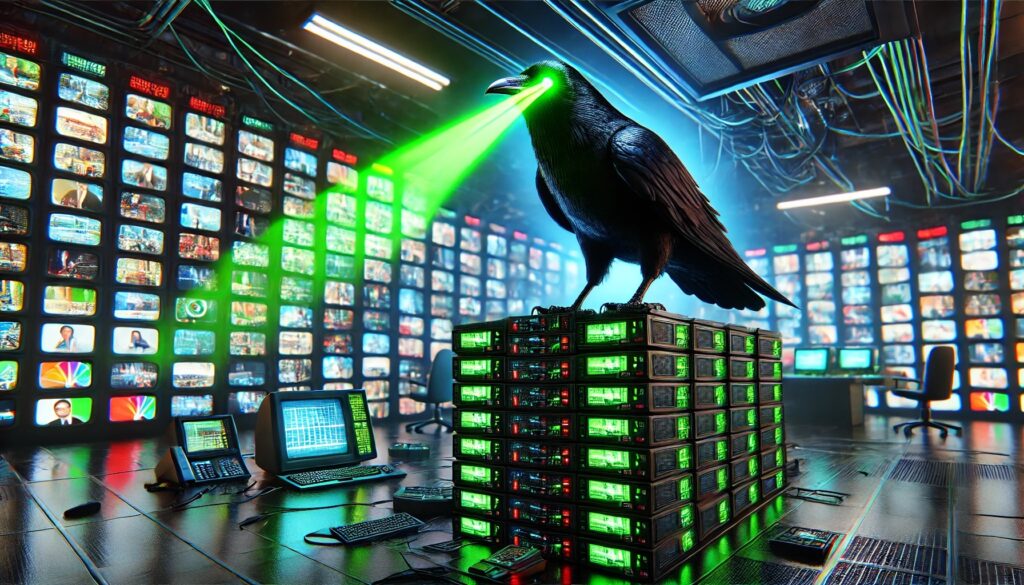The Ultimate Guide to Media Monitoring
Stop narrative threats before it’s too late. Investing in media monitoring can help you mitigate risk and control the narrative around your organization.

Image: Dall-E 3
Media monitoring has become essential for businesses looking to stay ahead of harmful narratives. This guide explores what media monitoring and narrative intelligence are, their benefits, and how they can be effectively implemented.
What is Media Monitoring?
Media monitoring involves tracking and analyzing various media channels, including traditional media (newspapers, magazines, radio, and television) and digital media (websites, social media, blogs, and forums). This process helps businesses understand public perception, track industry trends, and respond to media mentions in real-time.
Media monitoring can be enhanced significantly with narrative intelligence like Constellation by Blackbird.AI which automatically detects, analyzes, and measures risk, and gains context around the impact of emerging narratives to provide clarity for critical decision-making One in four risk executives believe reputational damage is their organizations’ most significant challenge in the next few years. However, most organizations cannot see narrative threats coming until it’s too late. Investing in media monitoring through narrative intelligence can help you mitigate risk and control the narrative around your organization.
LEARN MORE: What Is A Narrative Attack?
Benefits of Media Monitoring
There are many benefits to media monitoring, narrative intelligence, and paying attention to what is said about your organization online.
1. Understanding Public Perception
Media monitoring provides insights into what people say about your brand, products, or services. Analyzing these mentions allows businesses to gauge public sentiment and adjust their strategies accordingly.
Narrative intelligence enables you to see the harmful narratives impacting your organization, the contagion effect of the narrative as it spreads across networks, bot-driven manipulation, and the hyper-agenda-driven threat actors behind it so you can make better strategic decisions in times of crisis.
2. Crisis Management
In the event of a crisis, quick response is crucial. Media monitoring combined with narrative intelligence helps businesses detect potential issues early and respond promptly to mitigate damage. By tracking negative mentions and understanding their context, companies can craft appropriate responses and maintain their reputation.
3. Competitive Analysis
Monitoring competitors allows businesses to stay informed about their activities and strategies. This information can be used to identify their strengths and weaknesses, helping businesses to refine their approaches and gain a competitive edge.
4. Trend and Narrative Identification
By analyzing media trends and narratives, businesses can identify emerging opportunities and threats. This enables them to stay ahead of industry developments and adapt their strategies to capitalize on new trends.
5. Measuring Campaign Effectiveness
Media and narrative monitoring helps businesses measure the impact of their PR and marketing campaigns. By tracking media coverage and analyzing engagement metrics, companies can determine the effectiveness of their efforts and make data-driven decisions for future campaigns.
Types of Media Monitoring
Chances are your organization isn’t only being talked about on one channel. A sophisticated media monitoring strategy involves monitoring all forms of media and narratives.
1. Social Media Monitoring
Social media platforms are a goldmine of information about public opinion. Monitoring social media mentions allows businesses to engage with their audience, respond to feedback, and identify trending topics.
2. Online Reputation Management
Managing online reviews and ratings is crucial for maintaining a positive brand image. By monitoring review sites and responding to feedback, businesses can address customer concerns and improve their online reputation.
3. News Monitoring
Tracking mentions in traditional media helps businesses stay informed about their industry and competitors. News monitoring also allows companies to identify key opinion leaders and leverage media coverage to enhance their brand’s visibility.
4. Competitor Monitoring
Keeping an eye on competitors’ media coverage provides valuable insights into their strategies and performance. This information can inform business decisions and develop more effective marketing strategies.
5. Crisis Monitoring
Monitoring narratives across media channels for potential crises helps businesses detect issues early and respond effectively. This proactive approach can prevent minor issues from escalating into major crises.
Who Can Benefit from Media Monitoring?
If you are a company that interacts with the public in any way and you care about your reputation or public perception, then you need media monitoring and narrative intelligence. These valuable services can help you track what’s being said about your organization, industry, competitors, and relevant issues.
Startups and Mid-Sized Companies
Positive media coverage provides credibility to small and mid-sized organizations and is a powerful growth hack for your business. Earned media can draw attention to a company, helping drive prospects, customers, potential investors, and top talent. Negative media coverage can drastically impact new leads, customer retention, and business overall. Media monitoring can be a vital part of ensuring the future success of your business.
Enterprise Companies
Large companies need help sifting through all the noise to find the important news and narratives regarding their business. Enterprise companies need to be able to show the ROI of their PR activities, benchmark campaign performance, and communicate that information clearly to stakeholders. Risk management and crisis mitigation are vital to large enterprises, and media monitoring can help.
Government Agencies
Government agencies tend to be publicly funded and subject to higher scrutiny. Gaining the public’s confidence is vital to success, and avoiding their disdain is just as important. Government agencies can use media monitoring and narrative intelligence tools for managing issues, reputation management, risk management, crisis management, and future planning.
Advocacy Groups & Non-Profit Organizations
Specific issues drive these types of organizations. Media monitoring and narrative intelligence tools can warn an organization of outside risks and threats and uncover opportunities. Not only can these organizations use media monitoring tools to stay informed, but they can also use media monitoring to rally support, drive donations, and mobilize their community.
Learn more: Blackbird.AI for Public Sector Leaders
Implementing Media Monitoring
Now that you understand the risks and benefits of media monitoring and narrative intelligence, it’s time to put together an implementation plan.
1. Set Clear Objectives
Determine what you want to achieve with media monitoring. Whether improving brand perception, managing crises, or tracking competitors, having clear objectives will guide your monitoring efforts.
2. Choose the Right Tools
Various media monitoring and narrative intelligence tools are available, each with different features and capabilities. Choose a tool that aligns with your objectives and comprehensively covers the media channels relevant to your business.
3. Establish a Monitoring Routine
Regular monitoring is essential for staying informed and responsive. Establish a routine that includes daily, weekly, and monthly checks of media mentions and trends.
4. Analyze and Act on Insights
Collecting data is only the first step. Analyze the insights gained from media monitoring and use them to inform your strategies and decision-making processes. Respond to feedback, adjust your marketing efforts, and stay ahead of industry trends.
Control Your Narrative
Media monitoring combined with narrative intelligence provides businesses with valuable insights into public perception, industry trends, and competitor activities. Companies can improve their reputation, manage crises, and stay competitive in an ever-changing digital landscape by effectively implementing media monitoring and narrative intelligence.
Learn what Blackbird.AI can do to protect your organization from false and damaging narratives. Book your demo today.
Kandace Miller •
Need help protecting your organization?
Book a demo today to learn more about Blackbird.AI.



